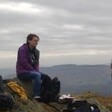Arts and Culture 26 September 2014

Artist Raed Issa holds up one of his damaged paintings in his bombed-out house in Gaza. (Photo courtesy of Raed Issa)
Gaza-based painter Raed Issa’s home was destroyed during this summer’s intensive Israeli attack on Gaza, which killed over 2,000 people. But, in the slow clear-up and under-resourced reconstruction which has followed, Issa has sought to find a way in which his burnt and crushed paintings can continue to convey a message.
His answer has been to display the paintings in the environment in which they were both created and destroyed, hanging them on lines strung through his wrecked home and studio, and holding them up himself amid the chaos. This series of photographs shared by Issa with The Electronic Intifada illustrate his stubborn insistence on finding resonance among the destruction, and on defying that destruction with humor and creativity.

Raed Issa has joked that his paintings have received no hospital treatment abroad. (Photo courtesy of Raed Issa)
Issa recently commented with irony on a Facebook gallery of some of the photos taken of this most site-specific of installations or exhibitions, saying:
Here are some of my paintings which have been salvaged from under the rubble of my destroyed studio in an attempt to save these works of art from direct injury. Although parts of them have been lost, these paintings have not traveled to hospitals abroad for treatment. However, they will be restored and their colors reinvigorated from the rubble of the very same studio to remain in a constant cycle of infinite giving and to haunt the perpetrators of these crimes against humanity.
Raed Issa’s paintings have been shown around the world, including as part of the Despite exhibition of Palestinian art from Gaza in London in 2012, and most recently in a touring show in Ireland. One of his Satellites series, which depicts vibrantly-colored landscapes of refugee camps, was also used as the cover image for the A Bird is Not a Stone anthology of Palestinian poetry, published earlier this year.

Eight families shared the apartment block which was destroyed during the summer. (Photo courtesy of Raed Issa)





